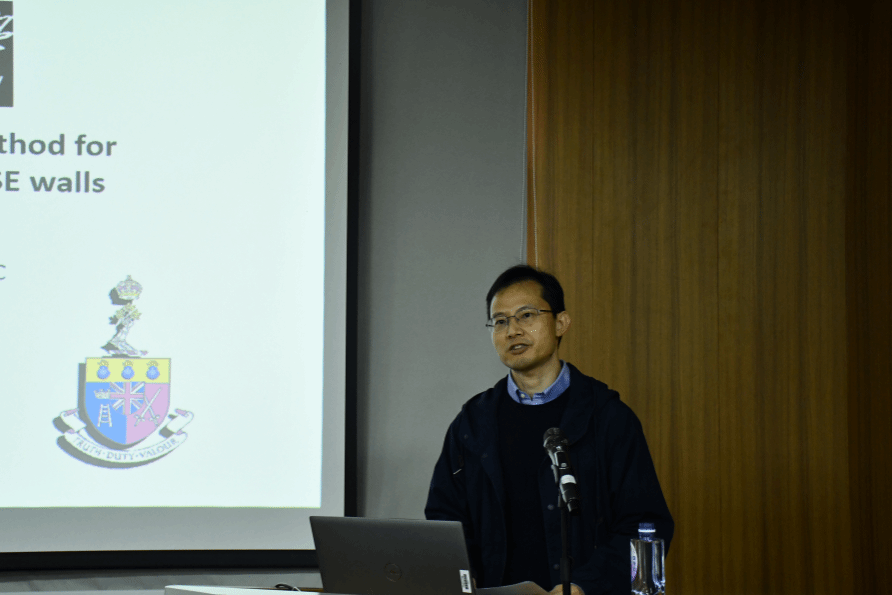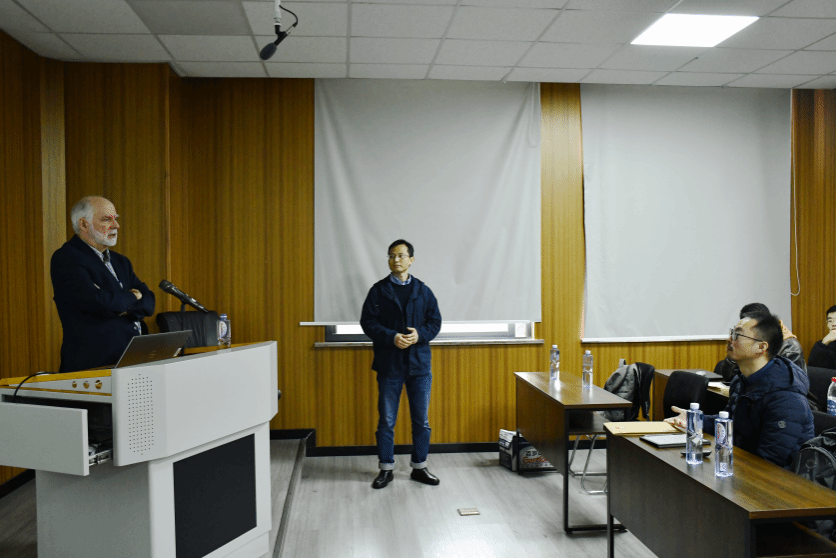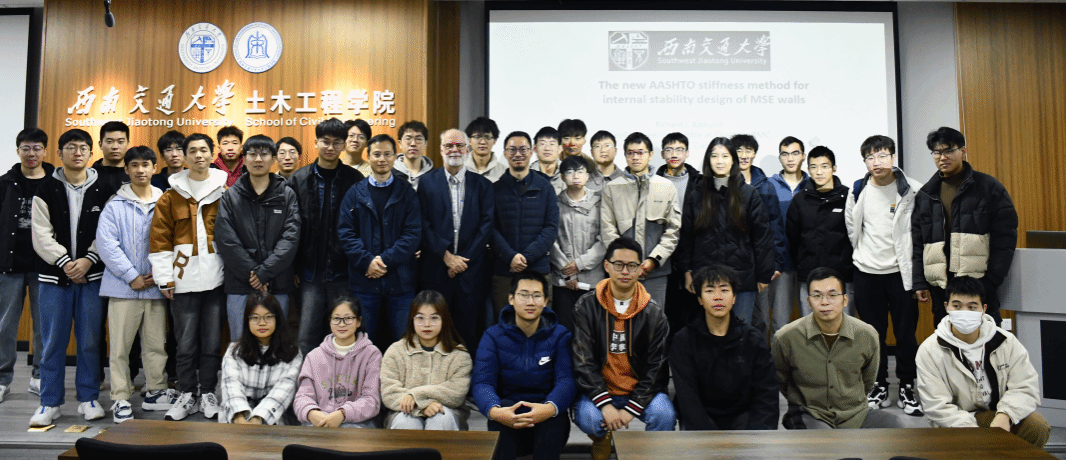Richard Bathurst, Professor Emeritus of Civil Engineering at the Royal Military College of Canada and an overseas scholar under the initiative of Geotechnical and Underground Engineering Intelligent Construction and Safety Overseas Expertise Introduction Center for Discipline Innovation gave a lecture on the topic “The New AASHTO Stiffness Method for Internal Stability Design of MSE Walls” on December 11 at the building of School of Civil Engineering (SCE) on Jiuli Campus. Chen Rong, Deputy Dean of SCE, and Associate Professor Yang Shangchuan, together with a full room of teachers and students were present. The lecture was presided by Professor Yu Yan from SCE. He gave a warm welcome to Professor Bathurst who also holds a cross-appointment at Queen's University, and is a Fellow of the Canadian Academy of Engineering, the Engineering Institute of Canada, and the Canadian Society for Civil Engineering.


Professor Bathurst first introduced the development and application of reinforced earth retaining wall systems, then analyzed the AASHTO Simplified Method for internal stability design of reinforced earth retaining walls in the early editions of published specifications, and then proved that the measured loads calculated by AASHTO Simplified Method were underestimated through demonstration of data. He concluded the Stiffness Method is more accurate when compared to measured loads in instrumented walls. There are essential differences between the two approaches based on the strength of the soil. A key feature of the Stiffness Method is the use of the creep-reduced tensile stiffness of the reinforcement as a key parameter to compute the magnitude of reinforcement loads under operational conditions.
In view of the shortcomings of the Simplified Method, the Stiffness Method proposed by Professor Bathurst was adopted in the most recent edition of the AASHTO LRFD Bridge Design Specifications published in 2020 in the United States.


In addition to the essential features of the AASHTO Stiffness Method, Professor Bathurst explained how the method was calibrated against a large database of measurements, and how to compare the advantages and disadvantages of the two methods by statistical analysis. He pointed out the benefits of the AASHTO Stiffness Method, for example, it is more helpful to select reinforcement design parameters, remove conservatism observed in Simplified Method design outcomes, and facilitate load and resistance factor design calibration.


After the lecture, Professor Bathurst and the participants had discussions on the application of the AASHTO Stiffness Method, and he shared his rich experience in this field of more than 40 years.
This academic lecture provides an opportunity for teachers and students of the SCE to have insightful exchanges with Professor Bathurst and has deepened their understanding of the international frontier technology and academic achievements. The SCE will continue to fulfill the commitment to inviting more internationally renowned experts and scholars for visits, building a broader academic exchange platform for teachers and students, and jointly promoting the development and progress of the field of civil engineering.
以下部分来自教授个人简介原文
Professor Richard J. Bathurst, Ph.D., FRSC, FEIC, FCAE, FCSCE, M.ASCE
Dr. Bathurst is Professor Emeritus of Civil Engineering at the Royal Military College of Canada where he has taught since 1980 and holds a cross-appointment at Queen's University. He is a past president of the Engineering Institute of Canada, the Canadian Geotechnical Society, the International Geosynthetics Society (IGS), and the North American Geosynthetics Society. Dr. Bathurst has authored or co-authored more than 220 journal papers and 250 other contributions. He has made contributions in the areas of micromechanics of granular soils, railway ballast, and track dynamics, pavements, unsaturated soil-geotextile behavior, constitutive modeling of geosynthetic soil reinforcement materials, new test methods, and the development of transparent granular soil surrogates for geotechnical laboratory-scale testing.
Dr. Bathurst’s primary research activities are focused on the use of geosynthetic and metallic reinforcement in earth retaining wall systems, numerical modeling, seismic performance and design of these systems, probabilistic design of reinforced and unreinforced soil structures, reliability-based design, load and resistance factor design (LRFD) calibration of soil-structures, and LRFD code development. Dr. Bathurst is Editor-in-Chief of the IGS peer-reviewed technical journal Geosynthetics International and Associate Editor of the International Journal of Geomechanics, and the IGS journal Geotextiles and Geomembranes. He is a Fellow of the Canadian Academy of Engineering, the Engineering Institute of Canada, and the Canadian Society for Civil Engineering. Dr. Bathurst was elected Fellow of the Royal Society of Canada in 2017, which is the highest academic honor in Canada. The “Richard Bathurst Lecture” was recently announced by the IGS in recognition of his lifetime contributions to the development of geosynthetic soil reinforcement technologies and the mission of the IGS. The lecture will be delivered at each quadrennial International Geosynthetics Conference of the IGS.
